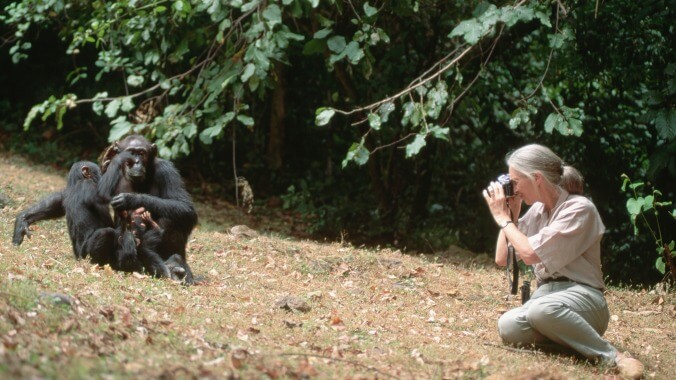Some apes Jane Goodall studied fought a years-long war

We explore some of Wikipedia’s oddities in our 5,938,838-week series, Wiki Wormhole.
This week’s entry: Gombe Chimpanzee War
What it’s about: Humanity has been waging war more or less continuously since the beginning of recorded history, but there’s at least one war you can’t pin on us, because it was fought by damned dirty apes! Two factions of chimpanzees in Tanzania fought a four-year war, and Dr. Jane Goodall was there to observe. And as always, Wikipedia is there to summarize.
Biggest controversy: Despite the fact that Jane Goodall was widely acknowledged as the world’s foremost expert in primate behavior, the scientific community was slow to believe her claims that there was a chimp war raging. Scientists at the time believed there was little to no overlap between human and animal behavior, and that war was a human concept that apes couldn’t possibly replicate. Others suggested Goodall herself had somehow disrupted the chimps’ “naturally peaceful society.” However, Goodall’s findings were borne out by later research. Once technology allowed scientists to observe apes long-term without intruding on their daily lives, it became clear that warfare was not uncommon.
Strangest fact: There may have been an ape Helen of Troy. Later researchers studying the events Goodall chronicled concluded that the likeliest reason for the conflict was a lack of available mates for the males in one faction. Goodall observed two factions of chimps in Gombe Stream National Park. The southern Kahama comprised six adult males, three adult females, and some younger apes. The northern Kasakela group had eight adult males to twelve females. While tensions had been brewing between the groups for some time, the first outright act of violence happened when six Kasakela males killed a Kahama chimp Goodall had named Gobi. By the end of the four-year-long war, all of the Kahama adult males were dead. One of the females was killed, two disappeared, and three were beaten and kidnapped by the Kasakela. (The jump from three adult females to six could be an inconsistency on Wikipedia’s part, but it’s also likely three adolescent females reached adulthood during the course of the war.)
Thing we were happiest to learn: Not much to be happy about in a series of murders among a now-endangered species. But the Gombe War at least helped to dispel the myth that animals are peaceful savages and humans are somehow uniquely violent. Even Goodall acknowledged she had preconceptions that had been shattered, saying she had considered chimps to be “rather nicer” than humans before observing the war.
Thing we were unhappiest to learn: Goodall didn’t just have her preconceptions challenged. She had to watch animals she had years-long relationships with brutally kill each other. In her memoir Through A Window: My Thirty Years With The Chimpanzees Of Gombe years later, she described images that haunted her of chimps’ violent behavior, using names she had given them: “Satan, cupping his hand below Sniff’s chin to drink the blood that welled from a great wound on his face… Jomeo tearing a strip of skin of Dé’s thigh… Figan, charging and hitting, again and again, the stricken, quivering body of Goliath, one of his childhood heroes.”
Also noteworthy: The war may have started over a male-female disparity, but like most wars, it ended up being about territory. The Kasakela took over the Kahama’s southern region, but their victory was short-lived. The Kahama had been serving as a buffer between their rivals, and the Kalande, a group larger and stronger than either. The Kalande quickly pushed the Kasakela out of their newfound territory.
Best link to elsewhere on Wikipedia: Another anthropologist would not have been surprised at the chimpanzee war: Raymond Dart, writing in the 1950s, proposed the killer ape theory, which posited that homo sapiens set ourselves apart from the other great apes by being more aggressive. This drive for dominance, so the theory goes, was a crucial step in our evolution.
Further down the Wormhole: Tanzania, the east African republic that’s home to Gombe Stream, was a German colony in the 19th century, but was handed over to Britain after WWI. Roughly 100,000 Tanzanians fought with the Allies in WWII, fighting against the Italians in Somalia, and the Vichy French in Madagascar. Vichy, in central France, was the capital of the Nazi-controlled puppet government set up by the Germans after invading the country in 1940. Before either World War, France—always a cultural powerhouse—pioneered the medium of film. One of those pioneers was Alice Guy-Blaché, the first woman to direct a film, and one of the first directors to use film to tell a fictional story. We’ll look at her groundbreaking work next week.